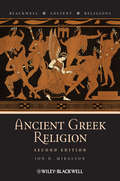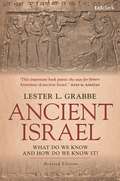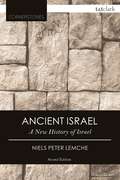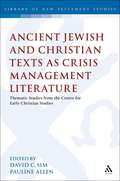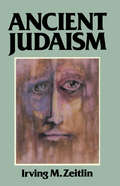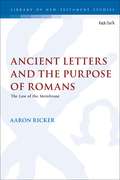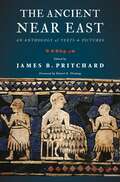- Table View
- List View
Ancient Greek Religion (Blackwell Ancient Religions #15)
by Jon MikalsonAncient Greek Religion provides an introduction to the fundamental beliefs, practices, and major deities of Greek religion. Focuses on Athens in the classical period Includes detailed discussion of Greek gods and heroes, myth and cult, and vivid descriptions of Greek religion as it was practiced Ancient texts are presented in boxes to promote thought and discussion, and abundant illustrations help readers visualize the rich and varied religious life of ancient Greece Revised edition includes additional boxed texts and bibliography, an 8-page color plate section, a new discussion of the nature of Greek “piety,” and a new chapter on Greek Religion and Greek Culture
Ancient Israel: Revised Edition
by Lester L. GrabbeIn Ancient Israel Lester L. Grabbe sets out to summarize what we know through a survey of sources and how we know it by a discussion of methodology and by evaluating the evidence. The most basic question about the history of ancient Israel, how do we know what we know, leads to the fundamental questions of Grabbe's work: what are the sources for the history of Israel and how do we evaluate them? How do we make them 'speak' to us through the fog of centuries? Grabbe focuses on original sources, including inscriptions, papyri, and archaeology. He examines the problems involved in historical methodology and deals with the major issues surrounding the use of the biblical text when writing a history of this period. Ancient Israel provides an enlightening overview and critique of current scholarly debate. It can therefore serve as a 'handbook' or reference-point for those wanting a catalogue of original sources, scholarship, and secondary studies. Grabbe's clarity of style makes this book eminently accessible not only to students of biblical studies and ancient history but also to the interested lay reader. For this new edition the entire text has been reworked to take account of new archaeological discoveries and theories. There is a major expansion to include a comprehensive coverage of David and Solomon and more detailed information on specific kings of Israel throughout. Grabbe has also added material on the historicity of the Exodus, and provided a thorough update of the material on the later bronze age.
Ancient Israel: A New History of Israel (T&T Clark Cornerstones)
by Niels Peter LemcheWhen this provocative text was first published, Lemche presented a new model of how we should understand Israelite society, its history and its religion. Lemche argues first that 'Israel' was the result of a social development among the Canaanite population of Palestine in the second half of the second millennium BCE. This implies that Israelite religion was originally 'Canaanite' and that what we think of as typically 'Jewish' religion did not arise until c. 500 BCE. Lemche's radical reassessment of Israelite history is based on the conviction that the Old Testament contains hardly any historical sources older than the seventh century BCE. The early history of Israel must therefore be reconstructed from archaeological results and non-biblical evidence, not from the Old Testament. In this new edition Lemche provides an extensive new introduction and bibliography, considering how the field has developed since the work first appeared.
Ancient Israel: A New History of Israel (T&T Clark Cornerstones #139)
by Niels Peter LemcheWhen this provocative text was first published, Lemche presented a new model of how we should understand Israelite society, its history and its religion. Lemche argues first that 'Israel' was the result of a social development among the Canaanite population of Palestine in the second half of the second millennium BCE. This implies that Israelite religion was originally 'Canaanite' and that what we think of as typically 'Jewish' religion did not arise until c. 500 BCE. Lemche's radical reassessment of Israelite history is based on the conviction that the Old Testament contains hardly any historical sources older than the seventh century BCE. The early history of Israel must therefore be reconstructed from archaeological results and non-biblical evidence, not from the Old Testament. In this new edition Lemche provides an extensive new introduction and bibliography, considering how the field has developed since the work first appeared.
Ancient Israel in Sinai: The Evidence for the Authenticity of the Wilderness Tradition
by James K. HoffmeierIn his pathbreaking Israel in Egypt James K. Hoffmeier sought to refute the claims of scholars who doubt the historical accuracy of the biblical account of the Israelite sojourn in Egypt. Analyzing a wealth of textual, archaeological, and geographical evidence, he put forth a thorough defense of the biblical tradition. Hoffmeier now turns his attention to the Wilderness narratives of Exodus, Leviticus, and Numbers. As director of the North Sinai Archaeological Project, Hoffmeier has led several excavations that have uncovered important new evidence supporting the Wilderness narratives, including a major New Kingdom fort at Tell el-Borg that was occupied during the Israelite exodus. Hoffmeier employs these archaeological findings to shed new light on the route of the exodus from Egypt. He also investigates the location of Mount Sinai, and offers a rebuttal to those who have sought to locate it in northern Arabia and not in the Sinai peninsula as traditionally thought. Hoffmeier addresses how and when the Israelites could have lived in Sinai, as well as whether it would have been possible for Moses to write down the law received at Mount Sinai. Building on the new evidence for the Israelite sojourn in Egypt, Hoffmeier explores the Egyptian influence on the Wilderness tradition. For example, he finds Egyptian elements in Israelite religious practices, including the use of the tabernacle, and points to a significant number of Egyptian personal names among the generation of the exodus. The origin of Israel is a subject of much debate and the wilderness tradition has been marginalized by those who challenge its credibility. In Ancient Israel in Sinai, Hoffmeier brings the Wilderness tradition to the forefront and makes a case for its authenticity based on solid evidence and intelligent analysis.
Ancient Israel's Neighbors (Essentials of Biblical Studies)
by Brian R. DoakWhether on a national or a personal level, everyone has a complex relationship with their closest neighbors. Where are the borders? How much interaction should there be? How are conflicts solved? Ancient Israel was one of several small nations clustered in the eastern Mediterranean region between the large empires of Egypt and Mesopotamia in antiquity. Frequently mentioned in the Bible, these other small nations are seldom the focus of the narrative unless they interact with Israel. The ancient Israelites who produced the Hebrew Bible lived within a rich context of multiple neighbors, and this context profoundly shaped Israel. Indeed, it was through the influence of the neighboring people that Israel defined its own identity-in terms of geography, language, politics, religion, and culture. Ancient Israel's Neighbors explores both the biblical portrayal of the neighboring groups directly surrounding Israel-the Canaanites, Philistines, Phoenicians, Edomites, Moabites, Ammonites, and Arameans-and examines what we can know about these groups through their own literature, archaeology, and other sources. Through its analysis of these surrounding groups, this book will demonstrate in a direct and accessible manner the extent to which ancient Israelite identity was forged both within and against the identities of its close neighbors. Animated by the latest and best research, yet written for students, this book will invite readers into journey of scholarly discovery to explore the world of Israel's identity within its most immediate ancient Near Eastern context.
ANCIENT ISRAEL'S NEIGHBORS EBS C (Essentials of Biblical Studies)
by Brian R. DoakWhether on a national or a personal level, everyone has a complex relationship with their closest neighbors. Where are the borders? How much interaction should there be? How are conflicts solved? Ancient Israel was one of several small nations clustered in the eastern Mediterranean region between the large empires of Egypt and Mesopotamia in antiquity. Frequently mentioned in the Bible, these other small nations are seldom the focus of the narrative unless they interact with Israel. The ancient Israelites who produced the Hebrew Bible lived within a rich context of multiple neighbors, and this context profoundly shaped Israel. Indeed, it was through the influence of the neighboring people that Israel defined its own identity-in terms of geography, language, politics, religion, and culture. Ancient Israel's Neighbors explores both the biblical portrayal of the neighboring groups directly surrounding Israel-the Canaanites, Philistines, Phoenicians, Edomites, Moabites, Ammonites, and Arameans-and examines what we can know about these groups through their own literature, archaeology, and other sources. Through its analysis of these surrounding groups, this book will demonstrate in a direct and accessible manner the extent to which ancient Israelite identity was forged both within and against the identities of its close neighbors. Animated by the latest and best research, yet written for students, this book will invite readers into journey of scholarly discovery to explore the world of Israel's identity within its most immediate ancient Near Eastern context.
Ancient Jewish and Christian Texts as Crisis Management Literature: Thematic Studies from the Centre for Early Christian Studies (The Library of New Testament Studies #445)
by David C. Sim Pauline AllenThis volume seeks to demonstrate, for the first time, that many Jewish and Christian texts in the ancient world were written as a direct response to an earlier situation of crisis that affected the author, or the intended reader. Presented here are texts from both traditions that were written over many centuries in order to establish that such crisis management literature was widespread in the religious and theological literature of ancient times. These chosen works reveal that all manner of crises could contribute to the production or the nature of these texts; including persecution, political factors, religious or theological differences, social circumstances; as well as internal or external threats. By understanding this crucial element in the composition of these texts we are better able to understand the complexity of social, political and religious forces that gave rise to many ancient theological texts, and to appreciate the strategies which the authors used to manage these crises.
Ancient Jewish Novels: An Anthology
by Lawrence M. WillsThis volume brings together for the first time all of the ancient Jewish novels and fragments of novels. Written at about the same time as the Dead Sea Scrolls and the New Testament, but before the period of Rabbinic Judaism, these texts reveal the ambiguities and conflicts encountered by Jews in this period.
Ancient Judaism: Biblical Criticism from Max Weber to the Present
by Irving M. ZeitlinThis book is a major contribution to the sociology of religion and to religious and biblical studies. Beginning from the classic work of Max Weber, the author analyses the origins of Judaism in the light of more recent scholarship. The result is a work that will become a standard point of reference in its field, and will be of great interest to the general reader as well as the specialist.
Ancient Judaism: Biblical Criticism from Max Weber to the Present
by Irving M. ZeitlinThis book is a major contribution to the sociology of religion and to religious and biblical studies. Beginning from the classic work of Max Weber, the author analyses the origins of Judaism in the light of more recent scholarship. The result is a work that will become a standard point of reference in its field, and will be of great interest to the general reader as well as the specialist.
Ancient Laws and Contemporary Controversies: The Need for Inclusive Biblical Interpretation
by Cheryl AndersonThe Ten Commandments condone slavery, and Deuteronomy 22 deems the rape of an unmarried woman to injure her father rather than the woman herself. While many Christians ignore most Old Testament laws as obsolete or irrelevant-with others picking and choosing among them in support of specific political and social agendas-it remains a basic tenet of Christian doctrine that the faith is contained in both the Old and the New Testament. If the law is ignored, an important aspect of the faith tradition is denied. In Ancient Laws and Contemporary Controversies, Cheryl B. Anderson tackles this problem head on, attempting to answer the question whether the laws of the Old Testament are authoritative for Christians today. The issue is crucial: some Christians actually believe that the New Testament abolishes the law, or that the Protestant reformers Luther, Calvin, and Wesley rejected the law. Acknowledging the deeply problematic nature of some Old Testament law (especially as it applies to women, the poor, and homosexuals), Anderson finds that contemporary controversies are the result of such groups now expressing their own realities and faith perspectives. Anderson suggests that we approach biblical law in much the same way that we approach the U.S. Constitution. While the nation's founding fathers-all privileged white men-did not have the poor, women, or people of color in mind when they referred in its preamble to "We the people." Subsequently, the Constitution has evolved through amendment and interpretation to include those who were initially excluded. Although it is impossible to amend the biblical texts themselves, the way in which they are interpreted can-and should-change. With previous scholarship grounded in the Old Testament as well as critical, legal, and feminist theory, Anderson is uniquely qualified to apply insights from contemporary law to the interpretive history of biblical law, and to draw out their implications for issues of gender, class, and race/ethnicity. In so doing, she lays the groundwork for an inclusive mode of biblical interpretation.
Ancient Laws and Contemporary Controversies: The Need for Inclusive Biblical Interpretation
by Cheryl AndersonThe Ten Commandments condone slavery, and Deuteronomy 22 deems the rape of an unmarried woman to injure her father rather than the woman herself. While many Christians ignore most Old Testament laws as obsolete or irrelevant-with others picking and choosing among them in support of specific political and social agendas-it remains a basic tenet of Christian doctrine that the faith is contained in both the Old and the New Testament. If the law is ignored, an important aspect of the faith tradition is denied. In Ancient Laws and Contemporary Controversies, Cheryl B. Anderson tackles this problem head on, attempting to answer the question whether the laws of the Old Testament are authoritative for Christians today. The issue is crucial: some Christians actually believe that the New Testament abolishes the law, or that the Protestant reformers Luther, Calvin, and Wesley rejected the law. Acknowledging the deeply problematic nature of some Old Testament law (especially as it applies to women, the poor, and homosexuals), Anderson finds that contemporary controversies are the result of such groups now expressing their own realities and faith perspectives. Anderson suggests that we approach biblical law in much the same way that we approach the U.S. Constitution. While the nation's founding fathers-all privileged white men-did not have the poor, women, or people of color in mind when they referred in its preamble to "We the people." Subsequently, the Constitution has evolved through amendment and interpretation to include those who were initially excluded. Although it is impossible to amend the biblical texts themselves, the way in which they are interpreted can-and should-change. With previous scholarship grounded in the Old Testament as well as critical, legal, and feminist theory, Anderson is uniquely qualified to apply insights from contemporary law to the interpretive history of biblical law, and to draw out their implications for issues of gender, class, and race/ethnicity. In so doing, she lays the groundwork for an inclusive mode of biblical interpretation.
Ancient Letters and the Purpose of Romans: The Law of the Membrane (The Library of New Testament Studies)
by Aaron RickerAaron Ricker locates the purpose of Romans in its function as a tool of community identity definition. Ricker employs a comparative analysis of the ways in which community identity definition is performed in first-century association culture, including several ancient network letters comparable to Romans. Ricker's examination of the community advice found in Rom 12-15 reveals in this new context an ancient example of the ways in which an inscribed addressee community can be invited in a letter to see and comport itself as a “proper” association network community. The ideal community addressed in the letter to the Romans is defined as properly unified and orderly, as well accommodating to – and clearly distinct from – cultures “outside.” Finally, it is defined as linked to a proper network with recognised leadership (i.e., the inscribed Paul of the letter and his network). Paul's letter to the Romans is in many ways a baffling and extraordinary document. In terms of its community-defining functions and strategies, however, Ricker shows its purpose to be perfectly clear and understandable.
Ancient Letters and the Purpose of Romans: The Law of the Membrane (The Library of New Testament Studies #630)
by Aaron RickerAaron Ricker locates the purpose of Romans in its function as a tool of community identity definition. Ricker employs a comparative analysis of the ways in which community identity definition is performed in first-century association culture, including several ancient network letters comparable to Romans. Ricker's examination of the community advice found in Rom 12-15 reveals in this new context an ancient example of the ways in which an inscribed addressee community can be invited in a letter to see and comport itself as a “proper” association network community. The ideal community addressed in the letter to the Romans is defined as properly unified and orderly, as well accommodating to – and clearly distinct from – cultures “outside.” Finally, it is defined as linked to a proper network with recognised leadership (i.e., the inscribed Paul of the letter and his network). Paul's letter to the Romans is in many ways a baffling and extraordinary document. In terms of its community-defining functions and strategies, however, Ricker shows its purpose to be perfectly clear and understandable.
Ancient Mediterranean Sacrifice
by Jennifer Wright Knust Zsuzsanna VarhelyiAn investigation of the multiple meanings and functions of sacrifice in diverse religious texts and practices from the late Hellenistic and Roman imperial periods.
Ancient Mystery Cults (Carl Newell Jackson Lectures #1)
by Walter BurkertThe foremost historian of Greek religion provides the first comprehensive, comparative study of a little-known aspect of ancient religious beliefs and practices. Secret mystery cults flourished within the larger culture of the public religion of Greece and Rome for roughly a thousand years. This book is neither a history nor a survey but a comparative phenomenology, concentrating on five major cults. In defining the mysteries and describing their rituals, membership, organization, and dissemination, Walter Burkert displays the remarkable erudition we have come to expect of him; he also shows great sensitivity and sympathy in interpreting the experiences and motivations of the devotees.
The Ancient Near East: An Anthology of Texts and Pictures (Ancient Near East: Classic Studies)
by James B. Pritchard Daniel E. FlemingJames Pritchard's classic anthologies of the ancient Near East have introduced generations of readers to texts essential for understanding the peoples and cultures of this important region. Now these two enduring works have been combined and integrated into one convenient and richly illustrated volume, with a new foreword that puts the translations in context. With more than 130 reading selections and 300 photographs of ancient art, architecture, and artifacts, this volume provides a stimulating introduction to some of the most significant and widely studied texts of the ancient Near East, including the Epic of Gilgamesh, the Creation Epic (Enuma elish), the Code of Hammurabi, and the Baal Cycle. For students of history, religion, the Bible, archaeology, and anthropology, this anthology provides a wealth of material for understanding the ancient Near East.Represents the diverse cultures and languages of the ancient Near East--Sumerian, Akkadian, Egyptian, Hittite, Ugaritic, Canaanite, and Aramaic--in a wide range of genres: Historical texts Legal texts and treaties Inscriptions Hymns Didactic and wisdom literature Oracles and prophecies Love poetry and other literary texts LettersNew foreword puts the classic translations in contextMore than 300 photographs document ancient art, architecture, and artifacts related to the textsFully indexed
Ancient Near Eastern Iconography and the Bible: Erwin Panofsky and Othmar Keel in Dialogue (The Library of Hebrew Bible/Old Testament Studies)
Examines the dilemma of whether ancient Near Eastern images – while providing unique aspects of the world-views of the cultures from which the Bible arose – can be interpreted in a way that traceably relates them to the biblical text. To avoid the danger of using images merely as illustrations for concepts found in the Bible, one first needs to behold the image with its own right to been seen. The essays within this volume describe the methods developed by Othmar Keel for bringing imagery into a dialogue with texts from the ancient Orient and their own interpretation, including previously unpublished material from Keel. The contributions begin with an overview of the scholarly work of Keel and the development of his aims and methods, including a revision of an article dealing with semiology in the interpretation of art. The book proceeds to address the research history of iconology in art history, presenting the methodology of Erwin Panofsky and one of his influential predecessors, Charles Clermont-Ganneau, in contrast with Keel's three methodological steps leading from iconographic analysis to iconology. Contributors then present two case studies of how Keel's method can be applied to interpret Egyptian and Mesopotamian images, allowing insights into the worldview of an ancient culture and the aim of iconology. The book concludes with a report about how iconographic analysis and iconology is taught on University level.
Ancient Persia and the Book of Esther: Achaemenid Court Culture in the Hebrew Bible
by Lloyd Llewellyn-JonesEsther is the most visual book of the Hebrew Bible and largely crafted in the Fourth Century BCE by an author who was clearly au fait with the rarefied world of the Achaemenid court. It therefore provides an unusual melange of information which can enlighten scholars of Ancient Iranian Studies whilst offering Biblical scholars access into the Persian world from which the text emerged.In this book, Lloyd Llewellyn-Jones unlocks the text of Esther by reading it against the rich iconographic world of ancient Persia and of the Near East. Ancient Persia and the Book of Esther is a cultural and iconographic exploration of an important, but often undervalued, biblical book, and Llewellyn-Jones presents the book of Esther as a rich source for the study of life and thought in the Persian Empire. The author reveals answers to important questions, such as the role of the King's courtiers in influencing policy, the way concubines at court were recruited, the structure of the harem in shifting the power of royal women, the function of feasting and drinking in the articulation of courtly power, and the meaning of gift-giving and patronage at the Achaemenid court.
Ancient Persia and the Book of Esther: Achaemenid Court Culture in the Hebrew Bible
by Lloyd Llewellyn-JonesEsther is the most visual book of the Hebrew Bible and largely crafted in the Fourth Century BCE by an author who was clearly au fait with the rarefied world of the Achaemenid court. It therefore provides an unusual melange of information which can enlighten scholars of Ancient Iranian Studies whilst offering Biblical scholars access into the Persian world from which the text emerged.In this book, Lloyd Llewellyn-Jones unlocks the text of Esther by reading it against the rich iconographic world of ancient Persia and of the Near East. Ancient Persia and the Book of Esther is a cultural and iconographic exploration of an important, but often undervalued, biblical book, and Llewellyn-Jones presents the book of Esther as a rich source for the study of life and thought in the Persian Empire. The author reveals answers to important questions, such as the role of the King's courtiers in influencing policy, the way concubines at court were recruited, the structure of the harem in shifting the power of royal women, the function of feasting and drinking in the articulation of courtly power, and the meaning of gift-giving and patronage at the Achaemenid court.
Ancient Philosophy of the Self (The New Synthese Historical Library #64)
by Pauliina Remes Juha SihvolaPauliina Remes and Juha Sihvola In the course of history, philosophers have given an impressive variety of answers to the question, “What is self?” Some of them have even argued that there is no such thing at all. This volume explores the various ways in which selfhood was approached and conceptualised in antiquity. How did the ancients understand what it is that I am, fundamentally, as an acting and affected subject, interpreting the world around me, being distinct from others like and unlike me? The authors hi- light the attempts in ancient philosophical sources to grasp the evasive character of the specifically human presence in the world. They also describe how the ancient philosophers understood human agents as capable of causing changes and being affected in and by the world. Attention will be paid to the various ways in which the ancients conceived of human beings as subjects of reasoning and action, as well as responsible individuals in the moral sphere and in their relations to other people. The themes of persistence, identity, self-examination and self-improvement recur in many of these essays. The articles of the collection combine systematic and historical approaches to ancient sources that range from Socrates to Plotinus and Augustine.
Ancient Prophecy: Near Eastern, Biblical, and Greek Perspectives
by Martti NissinenThis is an open access title available under the terms of a CC BY-NC-ND 4.0 International licence. It is free to read at Oxford Scholarship Online and offered as a free PDF download from OUP and selected open access locations. Ancient Prophecy: Near Eastern, Biblical, and Greek Perspectives is the first monograph-length comparative study on prophetic divination in ancient Near Eastern, biblical, and Greek sources. Prophecy is one of the ways humans have believed to become conversant with what is believed to be superhuman knowledge. The prophetic process of communication involves the prophet, her/his audience, and the deity from whom the message allegedly comes from. Martti Nissinen introduces a wealth of ancient sources documenting the prophetic phenomenon around the ancient Eastern Mediterranean, whether cuneiform tablets from Mesopotamia, the Hebrew Bible, Greek inscriptions, or ancient historians. Nissinen provides an up-to-date presentation of textual sources, the number of which has increased substantially in recent times. In addition, the study includes four analytical comparative chapters. The first demonstrates the altered state of consciousness to be one of the central characteristics of the prophets' public behavior. The second discusses the prophets' affiliation with temples, which are the typical venues of the prophetic performance. The third delves into the relationship between prophets and kings, which can be both critical and supportive. The fourth shows gender-inclusiveness to be one of the peculiar features of the prophetic agency, which could be executed by women, men, and genderless persons as well. The ways prophetic divination manifests itself in ancient sources depend not only on the socio-religious position of the prophets in a given society, but also on the genre and purpose of the sources. Nissinen contends that, even though the view of the ancient prophetic landscape is restricted by the fragmentary and secondary nature of the sources, it is possible to reconstruct essential features of prophetic divination at the socio-religious roots of the Western civilization.
Ancient Prophecy: Near Eastern, Biblical, and Greek Perspectives (Beihefte Zur Zeitschrift Für Die Alttestamentliche Wissenschaft Ser. #494)
by Martti NissinenThis is an open access title available under the terms of a CC BY-NC-ND 4.0 International licence. It is free to read at Oxford Scholarship Online and offered as a free PDF download from OUP and selected open access locations. Ancient Prophecy: Near Eastern, Biblical, and Greek Perspectives is the first monograph-length comparative study on prophetic divination in ancient Near Eastern, biblical, and Greek sources. Prophecy is one of the ways humans have believed to become conversant with what is believed to be superhuman knowledge. The prophetic process of communication involves the prophet, her/his audience, and the deity from whom the message allegedly comes from. Martti Nissinen introduces a wealth of ancient sources documenting the prophetic phenomenon around the ancient Eastern Mediterranean, whether cuneiform tablets from Mesopotamia, the Hebrew Bible, Greek inscriptions, or ancient historians. Nissinen provides an up-to-date presentation of textual sources, the number of which has increased substantially in recent times. In addition, the study includes four analytical comparative chapters. The first demonstrates the altered state of consciousness to be one of the central characteristics of the prophets' public behavior. The second discusses the prophets' affiliation with temples, which are the typical venues of the prophetic performance. The third delves into the relationship between prophets and kings, which can be both critical and supportive. The fourth shows gender-inclusiveness to be one of the peculiar features of the prophetic agency, which could be executed by women, men, and genderless persons as well. The ways prophetic divination manifests itself in ancient sources depend not only on the socio-religious position of the prophets in a given society, but also on the genre and purpose of the sources. Nissinen contends that, even though the view of the ancient prophetic landscape is restricted by the fragmentary and secondary nature of the sources, it is possible to reconstruct essential features of prophetic divination at the socio-religious roots of the Western civilization.
Ancient Religions (Blackwell Ancient Religions Ser.)
by Sarah Iles JohnstonReligious beliefs and practices, which permeated all aspects of life in antiquity, traveled well-worn routes throughout the Mediterranean: itinerant charismatic practitioners journeying from place to place peddled their skills as healers, purifiers, cursers, and initiators; and vessels decorated with illustrations of myths traveled with them. New gods encountered in foreign lands by merchants and conquerors were sometimes taken home to be adapted and adopted. This collection of essays by a distinguished international group of scholars, drawn from the groundbreaking reference work Religions of the Ancient World, offers an expansive, comparative perspective on this complex spiritual world.
